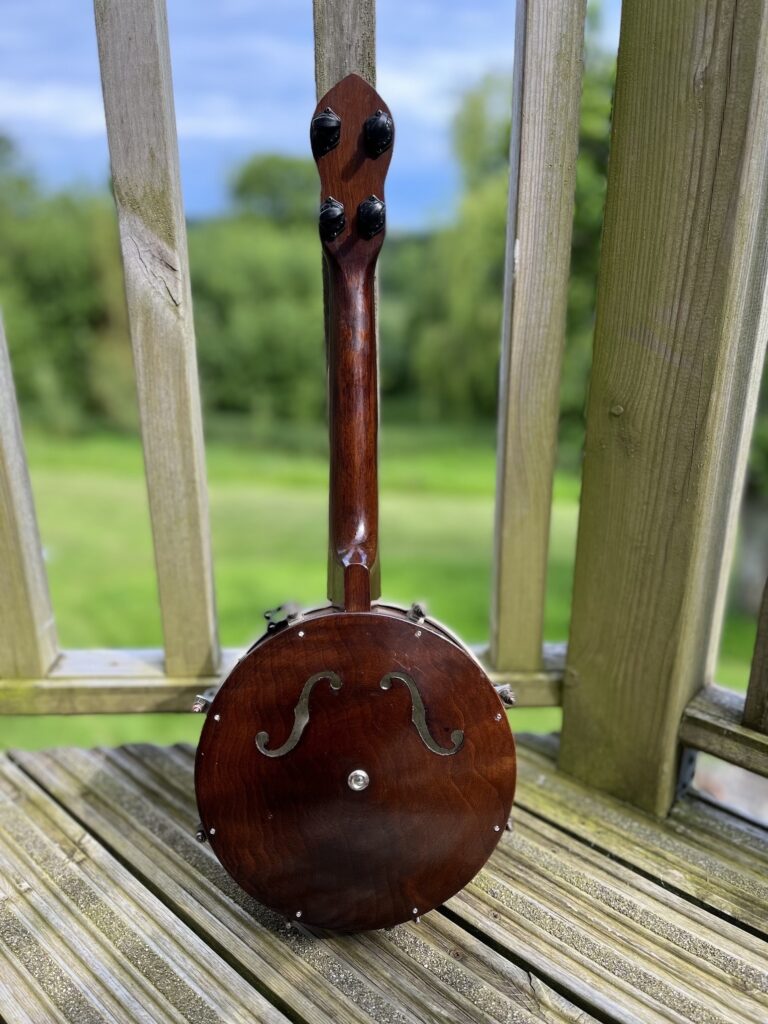do you have a banjo we can help with?
Dallas ‘George Formby’ Style A Banjolele Renovation
Project: Renovation of George Formby Style A Banjolele made by Dallas of London, Late 1940s to early 1950s
Current value – Unknown
Issues:
Generally dirty and many parts rusty
Bridge missing
Straight through Tuning Pegs not holding
Needs head cleaning and holes repaired
Good points:
It has all metal parts present
The neck is straight
The frets are in good condition.
The unusual ‘f-hole’ back is in good condition
This is a well known instrument, although of a basic design
Final value £120 and it’s for sale! If you’re interested in buying it why not call us.
Repair Gallery
Original Condition
Damaged and Rusty
It’s dirty, but otherwise not in unrecoverable condition – Just the way I like it!
The Calfskin Head has a few holes round the edge, I’m going to repair them rather than replace the head. It needs a bridge, tuners, and generally tidying up.
Back - Nailed on!
Now this is special! The back is a thin piece of walnut with f-holes. This makes it instantly recognisable as a George Formby Style A, made by Dallas in London in the late 1940s to early 1950s.
You might think the ‘A’ makes it sound the best of a series, but this is actually only the first and most basic of a 5 instrument series. This model sold for £1-10shillings (£1-50p) which was two weeks average wages at the time. At over £5 for the ‘E’, you had to be very wealthy to buy one of those! Fortunately, George Formby chose Dallas to custom-make Banjoleles for his stage use.
I replaced the nails with tiny stainless steel screws.
Damaged Neck
This damage goes well beyond ordinary neck wear from hand contact. The clue was in the case – an old capo with a rusty spring which fitted round the back of the neck. This will need rubbing down and restaining. See later pic for final ‘fixed’ appearance.
Fingerboard worn, Frets good.
The Fingerboard is badly worn from fingernails. It shows the instrument has had plenty of use.
On the other hand, the Frets are good.
Fingerboard Restored
Here’s the restored Fingerboard. It needed cleaning and re-blacking. I like using ordinary permanent black ink, slightly diluted, which I find soaks into the ebony and doesn’t then come off on the fingers. I think you’ll see the picture shows it’s an effective solution.
Straight Through Tuners
I did clean up the old Straight-Through Tuners but when I test-restrung the Banjolele the tuning was far too imprecise and they kept slipping… So, time for decent geared tuners.
Cleaned Head
The old Head was dirty and had a few small holes around the edge.
I cleaned it with a little mild soapy water on a soft cloth. I was careful not to get it too wet at this stage. It cleaned up well.
I repaired the small holes with tiny pieces of gauze. I used E6000 glue which works well on leather. This won’t affect the tone, as the repairs are right on the edge of the pot. After the glue dried, I could move on to installing the Head.
I soaked the Head in water for 30 minutes. It softened evenly, without coming off the Flesh Hoop. I put on the Tension Ring and tightened the J-Bolts by hand, then a little bit more with the wrench, going to and fro across the pot. I only did a little more than locking them into place, as I knew the Head would tighten more as it dried.
Geared 6:1 Ratio Tuners
Without enough forward-thinking, I installed a set of 90º 4:1 ratio geared Uke tuners, sourced from Eagle Music. They looked beautiful and worked perfectly, but I found that, as the head was now considerably wider, the instrument wouldn’t fit in the case!
As the case was original and still in good condition, I really wanted to use it – so, Plan B – I installed some Graphtech Tune-A-Lele 6:1 Ratio Planetary Tuners from Southern Ukulele Store. To my delight, one of the screw holes was in the same place as the 90º tuner’s.
Neck Repaired
Northwest Guitars supplies a lovely dark brown stain, which goes on well with a piece of lint-free rag. You have to use rubber gloves with this, it looks nearly black in the tin and stains your hands black very easily if you let it.
While I had the tin open, I also touched up multiple small dings and worn wood areas with a small artist’s paint brush.


